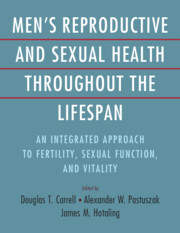 Men's Reproductive and Sexual Health Throughout the Lifespan
Men's Reproductive and Sexual Health Throughout the Lifespan Book contents
- Men’s Reproductive and Sexual Health throughout the Lifespan
- Men’s Reproductive and Sexual Health throughout the Lifespan
- Copyright page
- Contents
- Contributors
- Preface
- Section 1 An Introduction to Men’s Health Care
- Section 2 The Biology of Male Reproduction and Infertility
- Section 3 Clinical Evaluation and Treatment of Male Infertility
- Section 4 Laboratory Evaluation and Treatment of Male Infertility
- Chapter 20 The Modern Semen Analysis
- Chapter 21 The Future of Computer-Assisted Semen Analysis in the Evaluation of Male Infertility
- Chapter 22 Reactive Oxygen Species and Sperm DNA Damage
- Chapter 23 Clinical Value of Sperm DNA Fragmentation Tests
- Chapter 24 The Current Use of Sperm Function Assays
- Chapter 25 Sperm Selection in the Laboratory
- Chapter 26 Methods to Select Ejaculated, Epididymal, and Testicular Spermatozoa for Assisted Conception
- Chapter 27 Optimal Sperm Selection in the ICSI Era
- Chapter 28 Microfluidics for Sperm Sample Preparation and Sperm Identification
- Chapter 29 Practical Concerns for Patient Semen Banking
- Chapter 30 The Potential Future Applications of In Vitro Spermatogenesis in the Clinical Laboratory
- Chapter 31 Spermatogonial Stem Cell Culture and the Future of Germline Gene Editing
- Section 5 Medical and Surgical Management of Issues of Male Health
- Index
- References
Chapter 24 - The Current Use of Sperm Function Assays
from Section 4 - Laboratory Evaluation and Treatment of Male Infertility
Published online by Cambridge University Press: 06 December 2023
- Men’s Reproductive and Sexual Health throughout the Lifespan
- Men’s Reproductive and Sexual Health throughout the Lifespan
- Copyright page
- Contents
- Contributors
- Preface
- Section 1 An Introduction to Men’s Health Care
- Section 2 The Biology of Male Reproduction and Infertility
- Section 3 Clinical Evaluation and Treatment of Male Infertility
- Section 4 Laboratory Evaluation and Treatment of Male Infertility
- Chapter 20 The Modern Semen Analysis
- Chapter 21 The Future of Computer-Assisted Semen Analysis in the Evaluation of Male Infertility
- Chapter 22 Reactive Oxygen Species and Sperm DNA Damage
- Chapter 23 Clinical Value of Sperm DNA Fragmentation Tests
- Chapter 24 The Current Use of Sperm Function Assays
- Chapter 25 Sperm Selection in the Laboratory
- Chapter 26 Methods to Select Ejaculated, Epididymal, and Testicular Spermatozoa for Assisted Conception
- Chapter 27 Optimal Sperm Selection in the ICSI Era
- Chapter 28 Microfluidics for Sperm Sample Preparation and Sperm Identification
- Chapter 29 Practical Concerns for Patient Semen Banking
- Chapter 30 The Potential Future Applications of In Vitro Spermatogenesis in the Clinical Laboratory
- Chapter 31 Spermatogonial Stem Cell Culture and the Future of Germline Gene Editing
- Section 5 Medical and Surgical Management of Issues of Male Health
- Index
- References
Summary
Although semen analysis is the main routine test used in the diagnosis of male infertility, it is considered to be poorly predictive of male fertility status. Only recently, research in sperm biology focused on the development of assays to evaluate sperm functions necessary to reach and fertilize the oocyte and to allow a correct embryo development. However, the clinical utility of the currently proposed tests/assays remains a matter of debate, especially after introduction of ICSI. Ideally, since fertilization proceeds in a cascade-like manner, the goal would be to develop a single test able to evaluate all the aspects involved in this process and introduce it in ART laboratories. Such test should be simple, cheap, and not requiring expensive technology. Unfortunately, this aim is still far from being achieved. In this chapter, we discuss the most promising tests assessing sperm functions, describing their validity, limits, and potential use in clinical practice.
Keywords
- Type
- Chapter
- Information
- Men's Reproductive and Sexual Health Throughout the LifespanAn Integrated Approach to Fertility, Sexual Function, and Vitality, pp. 191 - 196Publisher: Cambridge University PressPrint publication year: 2023


